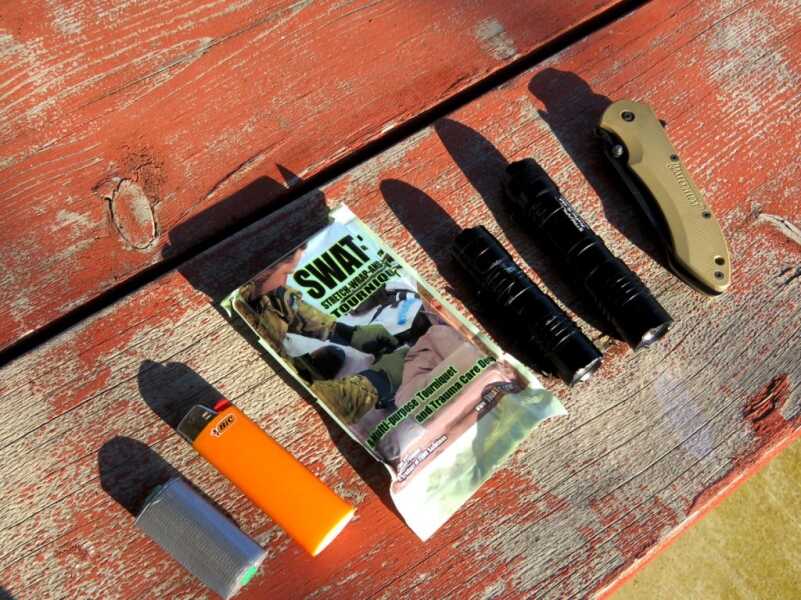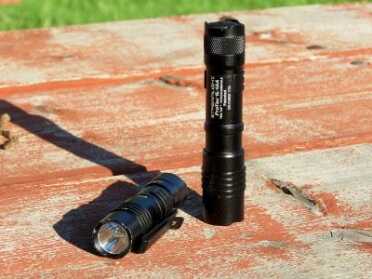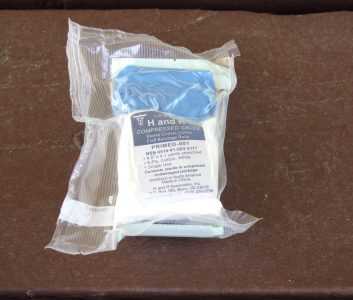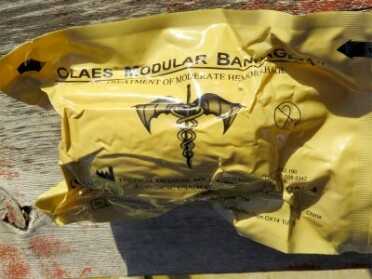There is a perception amongst some in our society that if there is no threat directly in front of them then there is no danger and therefore no reason to be prepared for what might happen. Everyday carry can mean different things to different people but it’s safe to say that if you’re reading this then typically the topic of EDC is going steer towards concealed carry firearms. A pistol is an excellent tool to have on your belt but it’s always best to have other tools in your toolbox.

These items can be easily concealed in regular pants pockets so that they can be used to better deal with whatever life may throw at you.

The Streamlight ProTac 1L 1AA can accept both AA and C123A batteries, which is very handy for an EDC light.
Tools of the Trade
It is becoming increasingly common for pistols to have very good LED rail-mounted lights attached to them. However, outside of life threatening circumstances, you can’t just go around pointing your pistol light at everything so you can see better. I’m a big believer in having a standalone illumination source that can be used as the primary light source with my concealed carry or as a backup to a pistol mounted light. There are a lot of great flashlights on the market. Streamlight makes high-quality rail-mounted lights and flashlights.
Lights, Bandages … Action!
I have two models from Streamlight, both are from their ProTac line, one is a Pro-Tac 1L and the other is a ProTac 1L-1AA. Both lights post some impressive stats, in terms of size and lumen output. The smaller ProTac 1L is less than 3½ inches long, uses a single C123A battery, and puts out an impressive 275 lumens. The ProTac 1L-1AA is a little longer at 4¼ inches, but that is because it can run on either a C123A or AA battery, but the output is increased to 350 lumens when using the C123A battery. Both lights feature Streamlight’s Ten-Tap programmable tail cap, which allows users to tailor the output to my needs by either running the light on high, low/high, or low/high/strobe. I have configured the light output for my two lights based on they general use, that is essential with or without a pistol. I primarily carry the 1L-1AA when I have my concealed carry on so I set the light up to be on the high power setting all the time. This way, if I need to use the light in conjunction with the pistol I have all the lumens available ready to go, I won’t have to cycle through a set. If I’m carrying the smaller ProTac 1L, it’s usually when I’m at work and can’t have my pistol so it’s set up to be on low then high power when I press the momentary tail cap. This way if I have to navigate a dark space or just find something in a bag I’m not doing it with a blinding 275 lumens.
Some may ask why I carry two different lights instead of just one and it’s a valid question. The ProTac 1L was the first Streamlight ProTac that I purchased for EDC and used it for quite some time by itself and in conjunction with the pistol. I soon realized that it was just a smidge too short while practicing the Harries, FBI, and Neck Index techniques for using a secondary light with a pistol.

With the light oriented bezel down, the author knows that when he can index it coming out of his pocket and the bright side will be pointed toward the threat.
While the short overall length was great for concealability and pocket carry, there were instances when I could actually occlude the front of the light with the heel of my palm after presenting it from the pocket. That could put me in a position where I would have reduced light output and reduced the range of which I could see a potential threat. As a result, I checked out the ProTac 1L-1AA and have so far found it to not have any of the drawbacks that the ProTac 1L did when using it with a pistol. The slightly longer length means that as it comes out of the pocket and I index it in my hand the tail cap and bezel protrude far enough beyond my palm that I haven’t any issues using it with a handgun.
When I first enlisted in the military we were trained on basic first aid with a field dressing who designs had not changed much since World War II. It was typical for each soldier to have two dressings, one for the entry wound, one for the exit wound, and that was essentially their IFAK. I can remember when the Israeli Bandage so common today was relatively new and we thought it was the best thing since sliced bread. Times have certainly changed and there are products out now that offer better performance and features at a reasonable cost compared to what was available just several years ago.
Trauma Kit

This homemade IFAK is similar to commercial Patrol officer IFAK’s and packs enough stuff to keep someone alive until help arrives. Contains an SWAT-T Tourniqet, compressed gauze, tape and gloves.
If you utilize a bag or purse to conceal your pistol it’s easy to have a small trauma kit that weighs next to nothing and is very compact so that it can go almost unnoticed. While gunshot wounds may be the first thing that jumps to someone’s mind when they think about trauma kits, the fact is that these components can be used for other injuries as well. A small EDC trauma kit that I carry to work every day consists of an SWAT-T Tourniquet, H&H Primed Gauze, Nitrile gloves, and duct tape. Sometimes this is supplemented with an Olaes Bandage from TacMed Solutions, which I consider to be the best bandage currently on the market. The small list of items above cannot just help me deal with major and minor bleeding but other minor wounds such as sprained ankles and even broken limbs. The heart of my small trauma kit is an SWAT-T tourniquet that is so versatile due to its elasticity, it can be used as a tourniquet, a pressure bandage, a way to secure a sprained ankle or splint a broken limb. Folded up in its packaging it’s about the size of a normal wallet and multiple tear points in the packaging means that it can be opened quickly when needed. The total size of this kit inside its vacuum sealed bag is about 4 ¾ inches by 2 ½ inches by 1 ½ inches, in scale that’s only slightly larger than a pack of cigarettes. If I’m going to be going into an environment where it may not be feasible to have the compact IFAK, in the very least I’ll slip the SWAT-T tourniquet into a pocket so that I can have some sort of lifesaving device with me.
Bandages

The Olaes Bandage is more than just another battle dressing. Designed by people that knew a thing or two about combat medicine, they’re worth having a few to spread amongst the house, car and boat.
Now, some readers may not be familiar with the Olaes Bandage but after this, you may have to get one for your briefcase, car, house, and hiking pack. Similar to the Israeli dressing, the Olaes bandage has an absorbent pad with elastic tails to stretch over an appendage to apply pressure to a wound. The similarities end there however because the Olaes bandage has some additional features to make it more versatile and easier to apply to an injury. The elastic tails have Velcro interrupters that keep the tails from rolling all the way out in case they’re dropped or let go off accidentally in the heat of the moment. The absorbent pad also contains a good amount of Z-folded gauze behind it that is useful for packing a wound, bandaging a separate wound, or to use on an entry or exit wound. A section of plastic is also stored behind the main pad that can be used to construct an occlusive dressing to help treat a sucking chest wound. The plastic cup on the back of the bandage that helps apply downward pressure to help stop bleeding but it can also be used as a makeshift eye cup to protect an eye injury. These bandages are available in 4-inch and 6-inch lengths, the 4-inch length is also available in a flat-packed version that is only about 1 inch thick, making it great for every day carry.
Cutting to the Chase
Of course, a knife is also a hot topic when it comes to everyday carry so I’m not going to get specifically into all the different brands and styles. I will briefly discuss what features that I’m looking for when I’m searching out an EDC knife and especially one that I’ll be carrying with my CCW. The knife has to be able to be opened quickly with one hand and preferably be ambidextrous so that it can be operated with either hand. I like a slim but comfortable grip that doesn’t feel bulky when I’m carrying it and feels good in the hand, which I feel gives me better control over the blade. In regards to the blade, I like a drop point with a straight edge that’s about 3½ inches long, for me, this strikes a good balance between utility and size. It’s been my experience that a knife about that size will be less conspicuous if you need to use it for everyday tasks but it’s still big enough that if you have to use it defensively it will be effective.
To wrap this up, my philosophy is that if I can carry these items on my person at all times while I’m concealed carrying then I can handle just about any situation that may occur. Even if I can’t carry my pistol the bulk of these items will allow me to effectively deal with emergencies and help me get home safe. I can defend myself, create warmth for myself, treat injuries, navigate, and even signal for help. Everyday carry items are going to be as varied and individual as the people carrying them but one principle should not change, if you carry it, know how to use it.
To learn more about Streamlight products, click https://streamlight.com.
To learn more about Swat Tourniquets, click https://www.swattourniquet.com.
To learn more about Tactical Medical Solutions bandages, click https://www.tacmedsolutions.com/product/olaes-modular-bandage/.
To learn more about Rescue Essential bandages and gauze, click https://www.rescue-essentials.com/h-h-primed-gauze/.
To purchase everyday carry essentials on GunsAmerica, click https://www.gunsamerica.com/Search.aspx?Keyword=knife.

Even though I don’t have much use for “tactical” pens, I did receive one as a gift. Along with a SureFire light, I take it when I travel by air, and TSA hasn’t made any objection.
Excellent advice. I am amazed at the number of people out there that have no clue regarding basic skills of first aid and simple survival even in an urban environment. Our culture/society has place the emphasis upon gadgets and electronic devices in lieu of basic skills and simple low-tech methodology. I am glad to see these types of articles and hope that they are not just “preaching to the choir”, but that people who are uninformed and who need this information will read and learn from them. Gracias.